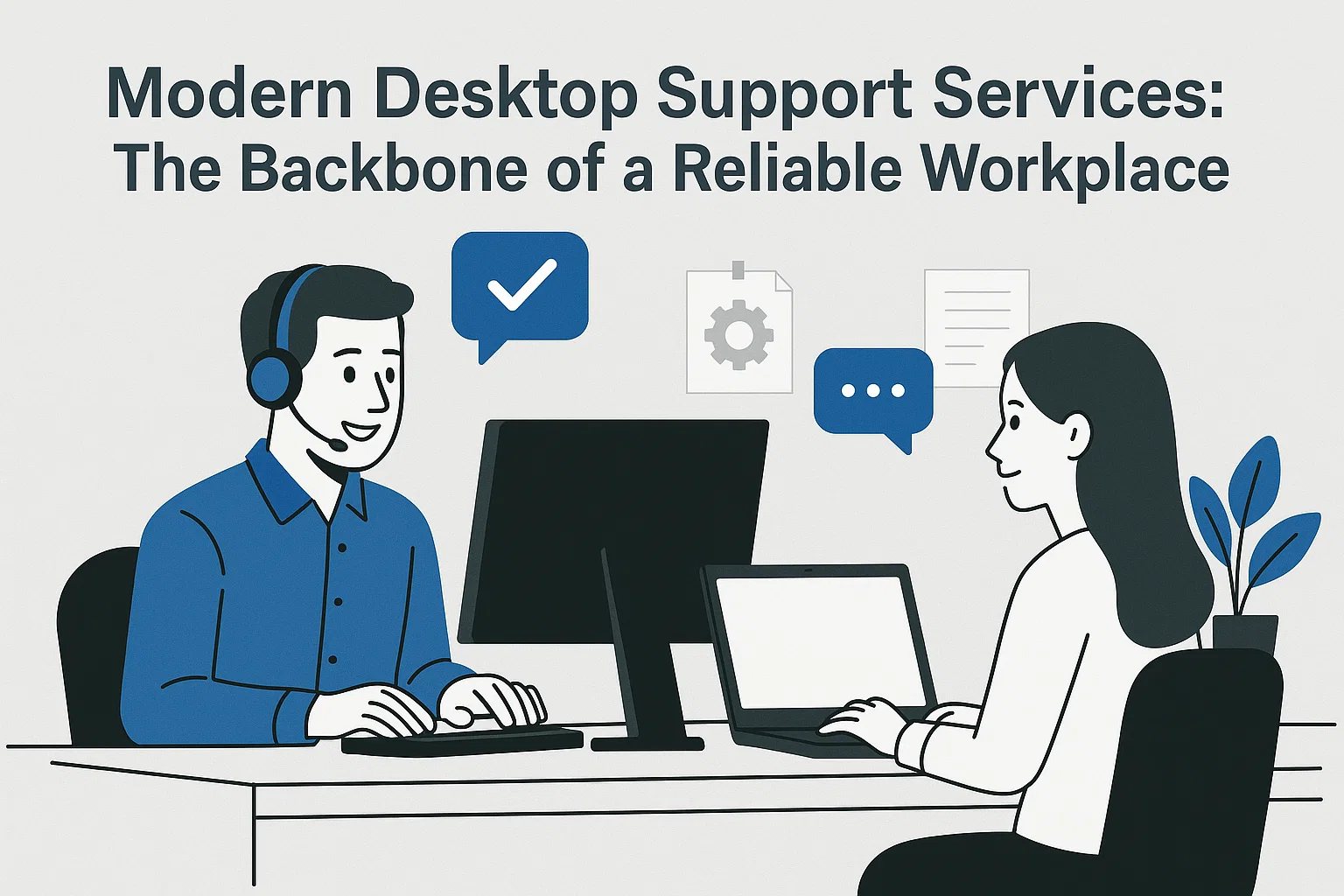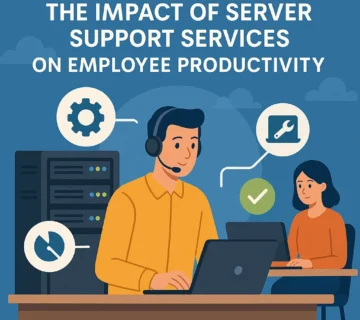Modern Desktop Support Services: The Backbone of a Reliable Workplace

Desktop support services keep your workplace technology running smoothly. When computers, software, or devices fail, your team can’t work efficiently. Modern desktop support ensures employees get quick help when tech problems arise.
In this guide, we’ll cover the most common desktop support challenges, what causes them, and how to resolve them quickly—whether you’re managing IT support for small businesses, enterprise desktop solutions, or implementing AI-powered support systems.
1. Slow Computer Performance
What’s the problem? Computers take forever to start up, open programs, or complete basic tasks.
Why it happens: Too many startup programs, insufficient RAM, or outdated hardware.
How to fix it:
- Disable unnecessary startup applications
- Add more RAM or upgrade to an SSD
- Run disk cleanup and remove temporary files
- Uninstall unused programs
Managed desktop support services can monitor performance remotely and fix issues before employees notice them.
2. Software Installation and Update Problems
What’s the problem?Applications refuse to install, system updates keep failing, or software begins crashing right after new updates are applied.
Why it happens: Compatibility issues, insufficient permissions, or corrupted installation files.
How to fix it:
- Run installations with administrator rights
- Check system requirements before installing
- Download fresh installation files from official sources
- Roll back problematic updates if needed
Enterprise desktop support teams typically use centralized management tools to push updates across all devices simultaneously.
3. Network Connectivity Issues
What’s the problem? Computers can’t connect to the office network, Wi-Fi keeps dropping, or internet access is unavailable.
Why it happens: Network adapter problems, incorrect settings, or router issues.
How to fix it:
- Restart the computer and network equipment
- Update network adapter drivers
- Forget and reconnect to the Wi-Fi network
- Check if IP settings are configured correctly
IT support for small businesses should include regular network health checks to prevent these disruptions.
4. Password Reset Requests
What’s the problem? Employees forget passwords and can’t access their computers or accounts.
Why it happens: Complex password policies and infrequent use of certain systems.
How to fix it:
- Implement self-service password reset portals
- Use password managers for the team
- Set up multi-factor authentication as backup
- Create clear password recovery procedures
AI desktop support systems can automate password resets through verified security questions or biometric authentication.
5. Printer and Peripheral Connection Problems
What’s the problem? Printers won’t print, scanners aren’t detected, or external devices don’t work.
Why it happens: Driver issues, connection problems, or outdated firmware.
How to fix it:
- Reinstall printer or device drivers
- Check USB ports and cables
- Update device firmware
- Restart the print spooler service
Remote desktop support can troubleshoot these issues without visiting the employee’s desk.
6. Email Client Errors
What’s the problem? Outlook or other email programs won’t send messages, sync properly, or crash frequently.
Why it happens: Profile corruption, server connection issues, or oversized mailboxes.
How to fix it:
- Repair the email profile or create a new one
- Archive old emails to reduce mailbox size
- Check server settings and credentials
- Update the email client to the latest version
7. Blue Screen of Death (BSOD)
What’s the problem? Computer crashes with a blue screen and error codes.
Why it happens: Hardware failures, driver conflicts, or corrupted system files.
How to fix it:
- Note the error code and research it
- Update all drivers, especially graphics and chipset
- Run Windows Memory Diagnostic
- Perform system file checker (SFC) scans
Managed desktop support providers track error patterns across your organization to identify widespread hardware or software issues.
8. Lost or Corrupted Files
What’s the problem? Important documents disappear or become unreadable.
Why it happens: Accidental deletion, hard drive failures, or malware infections.
How to fix it:
- Check the Recycle Bin first
- Restore from automatic backups
- Use file recovery software for deleted items
- Enable version history in cloud storage
Modern desktop support solutions include automated backup systems that protect data continuously.
9. Malware and Security Threats
What’s the problem? Computers run suspicious programs, display pop-ups, or behave strangely.
Why it happens: Clicking malicious links, downloading infected files, or outdated antivirus software.
How to fix it:
- Run full system scans with updated antivirus
- Remove suspicious browser extensions
- Update all software and operating systems
- Educate employees about phishing attempts
Enterprise desktop support includes advanced threat detection and endpoint protection across all devices.
10. Application Compatibility Issues
What’s the problem? Critical business software won’t run on newer operating systems or conflicts with other programs.
Why it happens: Legacy software not designed for modern systems or conflicting installations.
How to fix it:
- Run programs in compatibility mode
- Use virtual machines for outdated software
- Contact software vendors for updated versions
- Keep detailed documentation of known conflicts
AI-powered desktop support can predict compatibility issues before upgrades and suggest alternatives.
Desktop Support Services—FAQs
What are managed desktop support services?
Expert IT support designed to remotely and on-site monitor, manage, and resolve issues on employee workstations, ensuring optimal performance and minimal downtime. They handle everything from hardware repairs to software updates.
What is enterprise desktop support?
Comprehensive IT support designed for large organizations with hundreds or thousands of devices. It includes 24/7 help desks, asset management, and standardized configurations.
What is remote desktop support?
Technical assistance provided through internet connections, allowing IT staff to access and fix computers without being physically present.
What is AI desktop support?
Support systems using artificial intelligence to predict problems, automate solutions, provide instant chatbot assistance, and learn from past issues to prevent future ones.
Why is IT support for small businesses different?
Small businesses require affordable IT solutions that can support their operations without the need for a large in-house technical team. Services are often outsourced and focused on essential needs rather than complex enterprise features.
How quickly should desktop support respond?
Critical issues affecting business operations should receive responses within 15-30 minutes. Non-urgent requests typically get attention within a few hours.
Final Thoughts
Desktop support services are essential for maintaining workplace productivity. Whether you’re using managed desktop support services, building an internal enterprise desktop support team, or exploring AI-powered solutions, having reliable technical assistance keeps your business running without interruption.
Choose experienced IT support for small businesses or enterprise-level providers that offer proactive monitoring, quick response times, and comprehensive security to protect your technology investment and keep employees productive.







No comment